Different Type of Knitting Stitches – A Beginners Journey into Knitting
Knitting is a process or technique for producing a two-dimensional fabric made from a one-dimensional yarn or thread manipulated to create a textile.
This is one of the oldest methods. Basically, it interlinks or knots the series of loops of yarn using needles. New loops are intermeshed into the past loop structures. The knitting process can be done by hand or using a machine. It creates a significant level of stretchability.
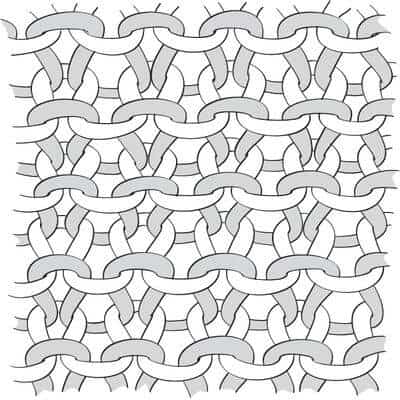
Fundamental Knitting Stitch
Knitting is just only the result of knit stitch and purl stitch. Those two linkers create all other knitting stitches. Therefore, to be an excellent knitter, one needs to boast the ability to differentiate between them easily.
But first, let’s take a close look at a single stitch.
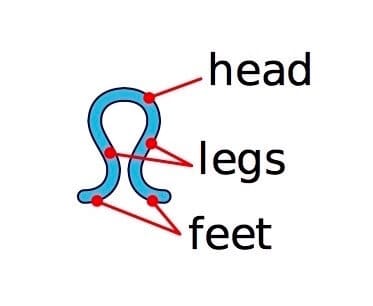 | You can clearly see its 3 distinctive parts. The bottom portion is known as the feet while the middle and top portions are termed as the legs and head, respectively. |
A knit stitch is formed when the two stitches are interlocked with each other, i.e, the feet interlocking with the head of the previous stitch. Now it goes without saying that –
Your knitting needle will always contain the top portion/ row of stitches
Identifying Knit Stitches
- There’s a “V” shape on the front (formed by the legs)
- Both the bottom(feet) and top(head) portion sits behind
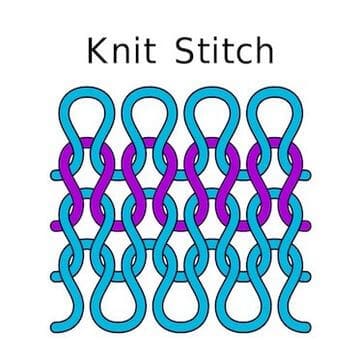
Identifying Purl Stitches
- It’s the exact oppostie of a knit stitch
- As expected, both the bottom(feet) and top(head) portion sits at the front
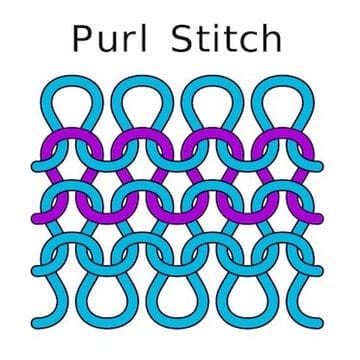
By now, you’ve probably guessed it. Yes, the purl stitches are formed on the backside when you create a knit stitch and vice-versa. Let’s close this section by taking a look at the following illustrations.
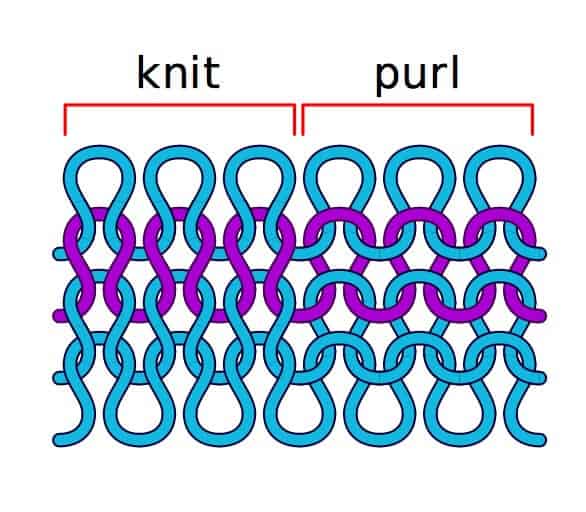
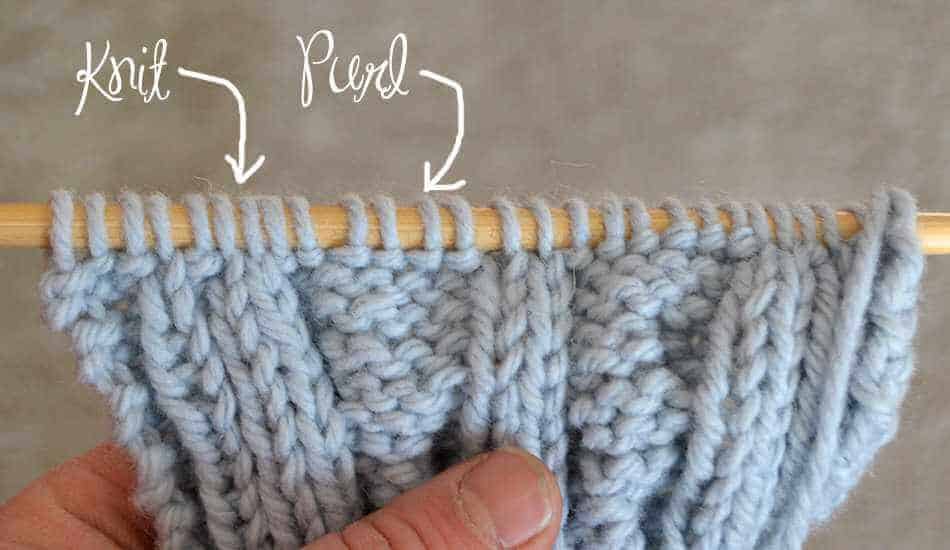
Different Type of Knitting Stitch
It’s almost impossible to cover all types of knitting stitches in a single article without boring you to death. That’s why I’ve picked only the most popular and relatively easy ones. Take a look!
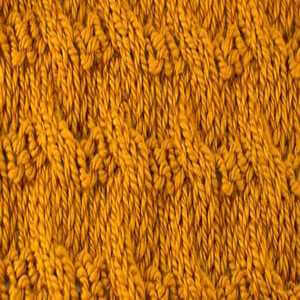 | 1. Sidecurl Pattern Stitch This pattern stitch creates a curvy cabled pattern. This stitch would be fantastic for blankets, scarves, and sweaters. Learn to Knit Sidecurl Stitch |
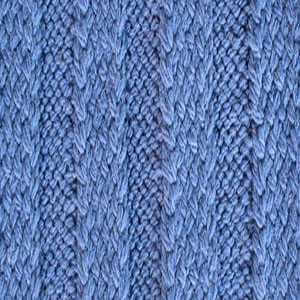 | 2. Wicker Stitch his is also called crisscross stitch. It’s a hybrid stitch between the cross stitch and a 2-stitch cable. The wicker pattern has the tightness to produce a dense and rigid fabric. It’s more likely used for blankets or scarves. Learn to Knit Wicker Stitch |
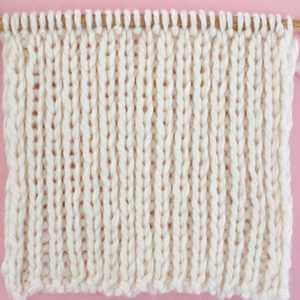 | 3. Rib Stitch This is mostly perfect for knit garments, especially collars, sweater bands, and cuffs. This 1×1 rib is a classic and stretchy pattern. One purl and one knit create this rib stitch pattern. Learn to Knit Rib Stitch |
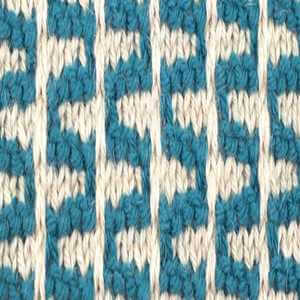 | 4. Russian Stitch This stitch generates zigzag columns. This is a mosaic colorwork pattern. The graphical design of this stitch is very easy. Learn to Knit Russian Stitch |
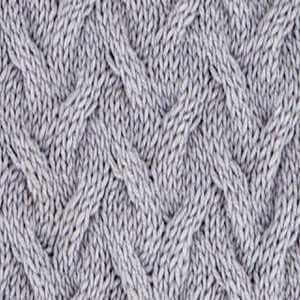 | 5. Cable Stitch Cables use the same knits and purls. It is a very intimidating skill to learn, but each step becomes very easy once you break down the difficulties. Learn to Knit Cable Stitch |
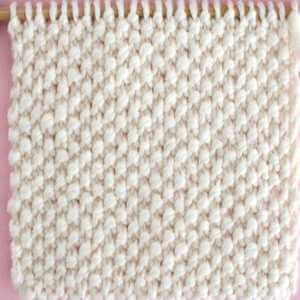 | 6. Seed Stitch The stitch is very simple but very popular for the texture and versatility. From knitted décor to scarves, cowls, and sweaters, the seed stitch is one of the most universal stitches for the knitters. This stitch gives a very bumpy look as it assimilates little seeds. Learn to Knit Seed Stitch |
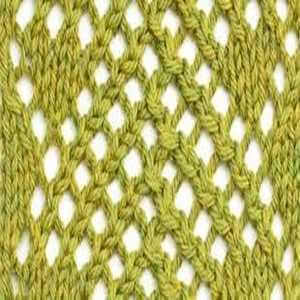 | 7. Double Herringbone Mesh Stitch This stitch pattern creates a geometric design with zigzag lines of stitches. It’s an alternate lace panel stitch with more difficult lace knitting patterns. This stitch is mainly used as long fabrics like light sweaters, blankets, and shawls. Learn to Knit Double Herringbone Mesh Stitch |
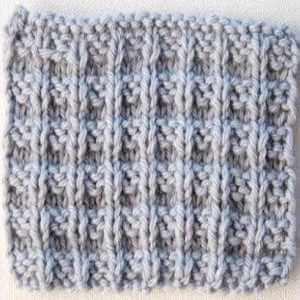 | 8. Deep Waffle Stitch This pattern stitch creates a lattice pattern with a very heavy texture. This fabric has a waffle look with shacks. With using mock cables, this pattern stitch is good enough for hats, blankets, and bulky scarves. Learn to Knit Deep Waffle Stitch |
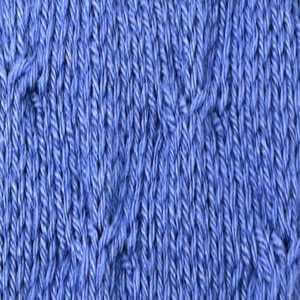 | 9. Little Bird Stitch It’s also a cable pattern stitch, and it looks like little birds perching all over the fabric’s surface. They are mainly used for market bags, pillows, hats, etc. Learn to Knit Little Bird Stitch |
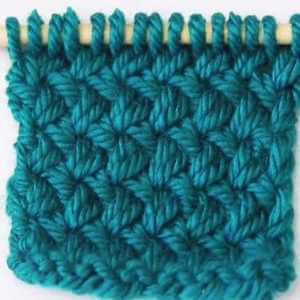 | 10. Woven Stitch This stitch pattern is great for a hat, bag, blanket, or washcloths. Used knit and purl stitch to transcribe basketweave genre patterns. Learn to Knit Woven Stitch |
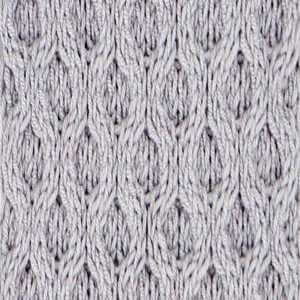 | 11. Honeycomb Cable Stitch This cable pattern stitch imitates the hexagonal shapes of honeycomb. Dense fabric is created, which is great for pillows, blankets, and other designs. Learn to Knit Honeycomb Cable Stitch |
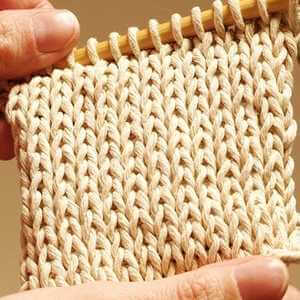 | 12. Stockinette StitchStocking stitch is one of the most common knitting skills. Interchanging rows of knit and purl stitches creates this pattern stitch.Learn to Knit Stockinette Stitch |
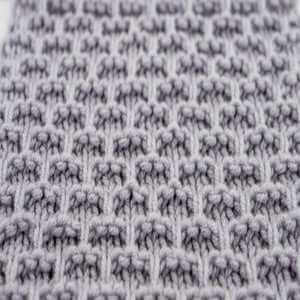 | 13. Brick Knitting Stitch It’s a great texture that simulates a running bond brick pattern. By using a slipped stitch, this heavily textured fabric is great for pillows, blankets, and most home decor. The feature of this stitch is geometric. Learn to Knit Brick Knitting Stitch |
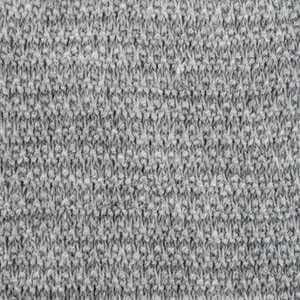 | 14. Garter Slip Stitch This stitch has some characteristics like a garter stitch and a slipped stitch. It creates a wonderful texture pattern stitch, which would be great for cowl, hats, and baby booties. It’s a very easy technique. Learn to Knit Garter Slip Stitch |
1. Sidecurl Pattern Stitch
Features
- Allover pattern
- Textured
Techniques Used
- Knit-k
- Purl-p
- Cable 4 Front-c4f
- More than a thousand available recipes
How to Knit Sidecurl Pattern Stitch?
To begin this stitch, we must cast on in multiples of 6+2.
Row-1: Beginning on the wrong side, purl all the stitches.
Row-2: Knit all the stitches.
Row-3: Purl all stitches.
Row:4: Knit all stitches.
Row-5: Begin by knitting 2, then begin the repeat by purling 4 and knitting too. Repeat this until the end of the row.
Row-6: Begin by purling 2, then begin the repeat by cabling for the front so we will slip the next 2 stitches onto our cable needle and hold them in front then knit 2 from the main needle and then knit the 2 from cable needle ending the yarn repeat by purling 2. Continue to repeat this until the end of the row.
Repeat rows 1 through 6 until we have reached the designed length, and that is how we knit the side curl pattern stitch.
Features
2. Wicker Stitch
- Mock cable
- Column
- Slipped stitch
- Woven
Techniques Used
- Knit-k
- Purl-p
- Cable 2 Forward-c2f
- Cable 2 Back-c2b
- Left twist
- Right twist
How to Knit Wicker Stitch?
To begin this stitch, we must cast on in multiples of 13+4.
- Row-1
Begin by purling 4. Then start the repeat by knitting one, and then the pattern is done by a left cross. This is the same thing as doing a cable 2 forward. Then taking the cable needle, slip the stitch onto our cable needle and hold that in front. Then knit the next stitch and knit the stitch from the cable needle.
For twisted stitch, we want the first stitch to twist over the second stitch, which is called the left twist. So, begin by knitting into the back of the second stitch and then knit into the front of the first stitch. This will produce a left-leaning stitch, and after that doing a total of four twists that is purl 4 and repeat the sequence all the way across until the end of the row.
- Row-2
Begin by knitting 4. Then starting the repeat by purling one, then work a right cross what our pattern refers to. Purl into the second stitch and leave this on the needle and then came back into the first stitch and then purl that stitch as well. Then drop these two stitches at once and then repeat that three more times. Repeat this sequence all the way across until the end of the row.
So, we will repeat rows 1 and 2 until we have reached the desired length, and that’s how we knit the wicker stitch.
3. Rib Stitch
Features
- Fascinating wrong side
- Ribbing
- Propagated
- Reversible
Techniques Used
- Knit-k
- Purl-p
How to Knit Rib Stitch?
To begin, we must cast on in multiples of two, so that is an even number of stitches. The first stitch is a knit stitch(k1), that is knitting one stitch and then bring the yarn to the front in order to purl. Just continue that same pattern in between the asterisks, that just means repeat between those two little stars.
So then, it is a purl one. Keep doing knit one purl one all the way down the row. Then turn needles around right here again, that is exactly the same thing on every single row. Knit one, bring the yarn around the purl one. Continue the k1, p1, and got the 1×1 rib stitch down.
So, the main process is like –
- Knit the two stitches.
- Bring the working yarn forward and purl two stitches.
- Bring the yarn backward and knit two stitches.
- Continue repeating these steps until finished the row.
So, follow the sequence of stitches. If the stitch below looks like a ‘V,’ we need to knit one stitch. If the stitch looks like a bar, we need to purl one stitch. We must remember, bring the working yarn backward for knit stitch and forwards for purl, or else we will tangle the work.
4. Russian Stitch
Features
- Columns
- Geometric
- Mosaic
- Slipped stitches
- Zigzag
Techniques Used
- Knit-k
- Purl-p
- With yarn in front-wyif
- With yarn in back-wyib
How to Knit Russian Stitch?
To begin the stitch, color ‘A’ is used to cast on in multiples of 5+1. Continue with color ‘A’ and knit one row.
- Row-1
Beginning on the right side of work, begin with color ‘B,’ which is going to be switch color to the other color. Just thread that through the hand like normally and make sure the tail is coming over our index finger.
Then slip the next stitch purlwise with the yarn in back and repeat this sequence all the way across until the last stitch in the row. To finish up the row, the last stitch in the row is going to be slipped purlwise into the next stitches with yarn and back by knitting.
- Row-2
Continue with color ‘B,’ doing purl one, and slip the next stitch purlwise with the yarn in front. This will start our repeat and then purl-4. Repeat the sequence all the way across until the end of the row.
- Row-3
Switch to color ‘A,’ capturing the yarn, making sure that it crosses over the working yarn. Begin by knitting-5 for row-3. Once we knit-5, start the repeat by slipping the next stitch purlwise with the yarn and back then knit-4. Repeat this sequence until reaching the last stitch in the row. Then knit knit-1.
- Row-4
Continue with color ‘A’ by knitting-5. Slip the next stitch purlwise with yarn in front. Then bring the yarn back and knit-4. Continue slipping one and knitting-4 until reaching the last stitch in the row. Finish up the row by knitting-1 when we reach the last stitch.
- Row-5
Switch back to color ‘B’ and begin by knitting one. Then start the repeat by slipping the next stitch purlwise with yarn and back. Then knit knit-4. Repeat this sequence all the way across until the end of the row.
- Row-6
Continuing with color ‘B,’ start the repeat by purling-4. Slip the next stitch purlwise with the yarn in front and repeat the sequence all the way across until the last stitch in the row. Finish up the row by purling one.
- Row-7
Switch back to color ‘A’ and repeat row-3, beginning by knitting-5. Start the repeat by slipping the next stitch purlwise with yarn and back with doing knit-4. Repeat this sequence all the way across until the last stitch in the row. Then knit knit-1.
- Row-8
Continuing with color ‘A,’ repeat roe-4, starting by knitting five. Bring the yarn front to begin the repeat and slip the next stitch purlwise and then bring the yarn back and knit-4. Repeat the sequence all the way across until the last stitch in the row. Then finish up b knitting-1.
So, repeat rows 1 through 8 until we have reached our desired length. That’s how we knit the Russian stitch.
5. Cable Stitch
Features
- Versatile
- Cubic
- Engrossing surface pattern
- Better elasticity
Techniques Used
- Purl-p
- Knit-k
How to Knit a Cable Stitch?
Work the first two rows of the pattern. Purl-2, Knit-6, and Purl-2 on the right side. Knit-2, Purl-6, and Knit-2 on the wrong side. Basically, row-1 is for the right side, and row-2 is for the wrong side. Then purl the first two stitches of row-3. Row-3 is the cable row.
First, you will have to start by passing the following two stitches onto the needle.
Then hold this needle just in front of the workpiece. This decides the direction of the twist leans. Now it’s time to knit the next 2 stitches. It’s done from the left-hand needle onto the right one. Finally, you can finish by knitting the stitches onto the right-handed one by using the cable needle.
Then we will hopefully see the crossover of the stitches. Then Knit-2, Purl-6, and Knit-2, which is row-4. Row-5 contains purl-2, knit-6, purl-2. Then row-6 decodes knit-2, purl-6, knit-2. Rows (4-6) are added in between the cable rows.
Putting some space elongates the braid a bit. It’s now ready for the second cable row. Then purl the first two stitches of the row and knit the next 2 stitches. Slip the next two stitches onto the cable needle, but hold the cable to the back of work.
By using the left needle, knit the next two stitches, leaving the needle inclined in the back. Then knit the two stitches by using a cable needle. Finish up the cable row by purling-2. Then work row-8, which is knit-2, purl-6, and knit-2 to finish the tress.
Repeat this sequence until we have reached our desired length.
6. Seed Stitch
Features
- Reversible
- Bumpy
- Textured
Techniques Used
- Knit-k
- Purl-p
How to Knit Seed Stitch?
To begin this stitch, we must cast on in any number of stitches.
- Row-1
Begin by knitting one. Bring the yarn to the front and purl-1. Then bring the yarn to the back and knit-1. Continue knitting-1 and purling-1 to the end of the row.
- Row-2
Knit the purls and purl the knits, that means if it shows a knit stitch, we have to do purl, and if it shows purl stitch, we have to do knit. Continue knitting the purls and purling the knits until the end of the row.
Repeat row-2 until we have reached the desired length. That’s how we knit Seed stitch.
7. Double Herringbone Mesh Stitch
Features
- Eyelet
- Openwork
- Panel
- Zigzag
Techniques Used
- Knit-k
- Purl-p
- Yarn Over-yo
- Slip Slip Knit-ssk
- Slip Stitch-sl st
- Pass Slipped Stitch Over-psso
- Knit 2 Together-k 2 tog
How to Knit Double Herringbone Stitch?
This stitch is worked over a panel of 21 stitches.
- Row-1
Beginning on the wrong side of the work, purl all stitches.
- Row-2
Knit-2. Yarn over and slip slip knit three times. Then yarn over, slip one, knit-2 together, and pass the slip stitch over. Yarn over and knit-2 together four times. Again, yarn over and end by knitting-2.
- Row-3
Purl all stitches.
- Row-4
Knit-3. Yarn over and slip slip knit three times. Then Yarn over, slip one, knit 2 together, and pass over the slip stitch. Then yarn over and knit-2 together three times. Yarn over again and end it by knitting-3.
- Row-5
Purl all stitches.
- Row-6
Knit-4. Yarn over and slip slip knit twice. Then yarn over, slip one, knit-2-together, and pass over the slip stitch. Then again yarn over and knit-4.
- Row-7
Purl all stitches.
- Row-8
Knit-2, knit-2 together, yarn over and knit-1. Yarn over and slip slip knit twice. Then yarn over, slip one, knit-2-together, and pass the slip stitch over. Then again yarn over and knit-2 together twice. Yarn over, knit-1. Yarn over, slip slip knit, and end by knitting-2.
- Row-9
Purl all stitches.
- Row-10
Knit-1, knit-2 together, yarn over, knit-3. Again, yarn over, slip slip knit. Then Yarn over, slip one, knit-2-together, and pass the slip stitch over. Yarn over, knit-3. Yarn over again, slip slip knit, and end by knitting-1.
- Row-11
Purl all stitches.
- Row-12
Knit-2 together, yarn over, knit-5. Yarn over, slip slip knit. Again, yarn over, slip one, knit-2 together, and pass the slip stitch over. Yarn over, knit-2 together. Then yarn over, knit-5. Yarn over and slip slip knit.
Repeat rows 1 through 12 until reaching the desired length. That’s how we knit the Double Herringbone Mesh stitch.
8. Deep Waffle Stitch
Features
- Allover pattern
- Mock cable
- Lattice
- Waffle
Techniques Used
- Knit-k
- Purl-p
- Knit 2 Together-k 2 tog
- Yarn Over-yo
- Slip Slip Knit-ssk
- Right Twist-RT
- Left Twist-LT
How to Knit Deep Waffle Stitch?
Begin this stitch by casting on a multiple of 4+2.
- Row-1
Begin on the right side purl-2. Then begin the repeat with a right twist and knit into the second stitch first. Then knit into the first stitch and pull them both off at the same time and then purl-2. Repeat this to the end of the row.
- Row-2
To begin by knitting. To begin the repeat by purling-2 and then knitting-2. Repeat this until the end of the row.
- Row-3
Begin by purling-1 and begin the repeat with a knit-2 together, yarn over twice and slip slip knit. Repeat from the start to the last stitch on the row, reaching the last stitch on the row by purling-1.
- Row-4
Begin by purling-2. Begin the repeat by knitting-1 and then purling-1 into the double yarn over from the row before with purl-2. Repeat this until the end of the row.
- Row-5
Begin by knitting-2. Begin the repeat by purling-2 and doing a left twist. For that, we have to knit into the back of the second stitch and then the front of the first stitch. Then pull them both off at the same time. Repeat this by the last four stitches on the row. By reaching the last four stitches, purl-2 and knit-2.
- Row-6
Begin by purling-2. Begin the repeat by knitting-2 and purling-2. Repeat this until reaching the end of the row.
- Row-7
Begin by purling-1. Then yarn over and begin the repeat by slip slip knit. Knit-2 together, yarn over twice, and repeat until the last 5 stitches on the row. By reaching the last 5 stitches, slip slip knit, knit-2 together, yarn over, and purl-1.
- Row-8
Begin by knitting-2. Then begin the repeat by purling-2. Then knitting-1 and purling-1 onto the double yarn over from the row before. Repeat this for the last four stitches on the row. By reaching the last four stitches on the row, do it by purling-2 and knitting-2.
Repeat row 1 through 8 until reaching the desired length. That’s how we knit Deep Waffle stitch.
9. Little Bird Stitch
Features
- Allover pattern
- Bird
- Minimal
- Textured
Techniques Used
- Knit-k
- Purl-p
- Slip Stitch-sl
- Cable 3 Right-c3r
- Cable 3 Left-c3l
How to Knit Little Bird Stitch?
To begin this stitch, we must cast on in multiples of 14+8.
- Row-1
Beginning on the right side of the work, knit all the stitch.
- Row-2
Purl all stitches.
- Row-3
Begin by knitting-10. Start the repeat by slipping the next two stitches purlwise onto the working needle and then knit-12. When we come to the last 12 stitches in the row, repeat the slip two and knit-12 until the last 12 stitches in the row. Slip the next two purlwise and then knit-10.
- Row-4
Begin by purling-10. Start the repeat by slipping the next two stitches purlwise to the working needle and then end the repeat by purling-12. Continue slipping-2and purling-12 until reaching the last 12 stitches in the row. Then slip the nest two stitches purlwise and finish up with purling-10.
- Row-5
Begin by knitting-8. Start the repeat by cabling three right. With a cable needle or a double-pointed needle, slip the next 2 stitches off of the main needle and hold these behind the work. Knit the next stitch off of the main needle, and this should be a slip stitch from the row before.
Then knit the next 2 stitches off of the cable needle and hold it in front, knit the next 2 stitches off of the main needle. Then knit this stitch off of the cable needle for cable three left. Finish the repeat by knitting-8. Repeat the cable three right and cable three left. Then knit-8 until the end of the row.
- Row-6
Purl all stitches.
- Row-7
Knit all stitches.
- Row-8
Purl all stitches.
- Row-9
Begin by knitting-3. Start the repeat by slipping the next two stitched purlwise and knit-12. Repeat the slip two and knit-12 until the last 5 stitches in the row. Slip the next 2 stitches purlwise and knit-3.
- Row-10
Begin by purling-3. Start the repeat by slipping the next 2 stitches purlwise and finish the repeat by purling-12. Repeat the slip two and purl-12 until the last 5 stitches in the roe. Then slip the next 2 stitches purlwise and purl-3.
- Row-11
Begin by knitting-1. Start the repeat by cabling 3 right. For this, we need a cable needle and then slip the next 2 stitches off of the main needle and hold behind. Knit the next stitch off of the main needle and then knit the 2 stitches off of the cable needle.
Then do a cable 3 left with the help of cable needle and slip the next stitch off of the main needle. Hold that in front and knit the next two stitches off of the main needle and knit stitch off of the cable needle. Then finish the repeat by doing knit-8.
Continue repeating the sequence until the last seven stitches in the row. Then do a cable 3 right. So, slip the next 2 stitches onto the cable needle. Hold and back to knit the next stitch off of the main needle and the 2 stitches off of the cable needle.
Then do a cable 3 left. Slip the next stitch and hold it in front, then knit-2 off of the main needle and then knit the stitch off of the cable needle. Finish it up by knitting-1.
- Row-12
Purl all stitches.
Repeat rows 1 through 12 until reaching the desired length. That’s how we knit Little Bird stitch.
10. Woven Stitch
Features
- Allover pattern
- Woven
- Textured
Techniques Used
- Knit-k
- Purl-p
How to Knit Woven Stitch?
To begin this stitch, we must cast on in multiples of 4+2.
- Row-1
Beginning on the right side of the work, knit all the stitches.
- Row-2
Purl all stitches.
- Row-3
Begin by knitting-2. Start the repeat by purling-2. Finish the repeat by knitting-2. Continue purling-2 and knitting-2 until the end of the row.
- Row-4
Begin by purling-2. Start the repeat by knitting-2 and finish the repeat by purling-2. Continue knitting-2 and purling-2 until the end of the row.
- Row-5
Knit all stitches.
- Row-6
Purl all stitches.
- Row-7
Begin by purling-2. Start the repeat by knitting-2 and finish the repeat by purling-2. Continue knitting-2 and purling-2 until the end of the row.
- Row-8
Begin by knitting-2. Start the repeat by purling-2 and finish the repeat by knitting-2. Continue purling-2 and knitting-2 until the end of the row.
Repeat row 1 through 8 until reaching the desired length. That’s how we knit the Woven stitch.
11. Honeycomb Cable Stitch
Features
- Allover pattern
- Circle
- Honeycomb
Techniques Used
- Knit-k
- Purl-p
- Cable Four Back-C4B
- Cable Four Forward-C4F
How to Knit Honeycomb Cable Stitch?
To begin this stitch, we must cast on in multiples of 8.
- Row-1
Beginning on the right side of the fabric, take cable needle or double-pointed needle and slip the first 2 stitches off of the main needle. Hold those behind the work and knit the next 2 stitches off of the main needle, which is cabling for the back.
Keep the cable/double pointed needle in hand and slip 2 more stitches off of the main needle. This time hold those stitches in front of the work. So, this is cabling for the front.
Then knit the next 2 stitches off of the main needle and stitches off of the cable needle. Repeat cable for back and cable for front until the end of the row.
- Row-2
Purl all stitches.
- Row-3
Knit all stitches.
- Row-4
Purl all stitches.
- Row-5
Take the cable needle and slip the first 2 stitches off the main needle. Pull those to the front of the work. So, this is cabling for the front. Then take the knitting needle and knit the first 2 stitches off the main needle. Knit the next 2 stitches off of the cable needle.
Hold that in back. So, that is cable for the back. Knit the next two stitches off of the main needle and then the 2 stitches off of the cable needle. So, repeat cable for front and cable for back until the end of the row.
- Row-6
Purl all stitches.
- Row-7
Knit all stitches.
- Row-8
Purl all stitches.
Repeat rows 1 through 8 until reaching the desired length. That’s how we knit Honeycomb Cable stitch.
12. Stockinette Stitch
Features
- Row 1-knit
- Row 2-purl
- Front side – ‘V’ stitches
- Backside – Garter bumps
Techniques Used
- Slip knot
- Cast on longtail method- co
- Knit-k
- Purl-p
- Bind off-BO
- Weave in ends
How to Knit Stockinette Stitch?
Do garter stitch on the front 2 stitches, which is basically just knitting the first 2 stitches on both sides. The first row is just for knitting. Keep knitting until the very end of the row.
Then do purl all the way across up until getting the last 2 stitches, which will be knit for garter because of the edges. Just knitting one row and purling the next.
That’s how we knit the Stockinette stitch.
13. Brick Knitting Stitch
Features
- Geometric
- Slipped stitches
- Textured
Techniques Used
- Knit-k
- Purl-p
- Slip stitch- sl st
- Yarn Forward- yf
- Yarn Back- yb
How to Knit Brick Stitch?
To begin this stitch, we must cast on in multiples of 4+1.
- Row-1
Beginning on the right side, knit-4. Begin the repeat by knitting the next stitch but wrapping the yarn twice around the working needle and pull both of the loops through the knit stitch. Finish the repeat by knitting-3. Continue the repeat until reaching the last stitch and then knit-1.
- Row-2
Begin by purling-4 stitches. Begin the repeat by slipping the next stitch purlwise and letting the second loop drop off the main needle. Finish the repeat by purling-3. Continue the repeat until reaching the last stitch. Then purl-1.
- Row-3
Begin by knitting-4. Begin the repeat by slipping the next stitch purlwise and then knitting-3. That will end the repeat. Continue the repeat until the last stitch of the row. Then knit-1.
- Row-4
Begin by knitting-4. Begin the repeat by bringing the yarn in back, slipping the next stitch purlwise, and then bringing the yarn in front. Finish the repeat by knitting-3. Continue bringing the yarn in back, slipping the stitch, and knitting-3 until reaching the last stitch. Then knit-1.
- Row-5
Begin by knitting-2. Start the repeat by knitting the next stitch while wrapping the yarn 2 times around the working needle. Pull it through the knit stitch. End the repeat by knitting-3. Continue the repeat until reaching the last 3 stitches. Then knit the next stitch by wrapping the yarn twice around the needle and then knit-2.
- Row-6
Begin the row by purling-2. Start the repeat by slipping the next stitch purlwise and letting the extra drop off the main needle, which will give an elongated stitch. Then purl-3. Continue the repeat until the last 3 stitches of the row. Then slip one purlwise and purl-2.
- Row-7
Begin by knitting-2. Slip the next stitch purlwise to begin the repeat and knit-3 to finish the repeat. Continue the repeat until the last 3 stitches of the row. Then slip one purlwise and knit-2.
- Row-8
Begin the row by knitting-2. Start the repeat by bringing the yarn in back or forward, slipping the next stitch purl-wise, and bringing the yarn in back. Finish the repeat by knitting-3.
Continue the repeat until reaching the last 3 stitches. Bring the yarn forward, slip the next stitch purl-wise, bring the yarn in back, and then knit-2.
So, repeat rows 1 through 8 until reaching the desired length. That’s how we knit the Brick stitch.
14. Garter Slip Stitch
Features
- Garter stitch
- Slipped stitch
- Textured
Techniques Used
- Knit-k
- Slip stitch- sl st
- Yarn forward- yf
- Yarn back- yb
How to Knit Garter Slip Stitch?
To begin this stitch, we must cast on in multiples of 2+1.
- Row-1
Beginning on the right side of the work, knit all stitches.
- Row-2
Knit all stitches.
- Row-3
Begin by knitting-1. Start the repeat by slipping the next stitch purl-wise and then finish by knitting-1. Continue slipping purl-wise and knitting-1 until the end of the row.
- Row-4
Begin by knitting-1. Start the repeat by bringing the yarn forward, and slip the next stitch purl-wise, bring the yarn back. Then knit-1. Repeat the sequence until the end of the row.
- Row-5
Knit all stitches.
- Row-6
Knit all stitches.
- Row-7
Begin by knitting-2. Slip the next stitch purl-wise to begin the repeat by knitting-1. Continue slipping purl-wise and knitting-1 until reaching the last stitch of the row. Then knit-1.
- Row-8
Begin by knitting-2. Start the repeat by bringing the yarn forward, slip the next stitch purl-wise, bring the yarn back, and knit-1. Repeat the sequence all the way until the last stitch in the row. Then knit-1.
So, repeat rows 1 through 8 until reaching the desired length. That’s how we knit the Garter Slip stitch “V.”
This type of stitch is very popular while using yarn for knitting slippers.
Frequently Asked Questions
What is knitting rows and stitches?
Knit stitch is a “V” shape pattern. Each “V” is a stitch in a row. By counting the V rows from bottom to top of knitting, we can identify it.
What is the easiest stitch in knitting?
- Garter stitch
- 1×1 Rib stitch
- Moss stitch
- Purl Ridge stitch etc.
What is the easiest thing to knit for the beginners?
- Simple knit baby hat
- Cozy ribbed scarf
- Garter stitch knit bag
- Knit hedgehogs
- Easy chunky knit baby blanket if you know what knitting needles to use for a big blanket
Is purl the opposite of knit?
Knit stitches look like purls and purls look like knit. Knitting the opposite of the row and purling the next row gives the backward quality, which makes stockinette stitch. The front of the knit and back of purl look the same.
Why do we keep getting more stitches when we knit?
Faulty knitting into the space between the stitches is the common reason for causing extra stitches. An accidental yarn occurs when the yarn is brought to the front of the work.
Are Different Knitting Stitches Helpful in Avoiding Holes When Changing Colors?
Yes, different knitting stitches can definitely help avoid holes when changing colors. For example, the slip stitch technique can be very effective in preventing holes when transitioning from one color to another. By incorporating this method into your knitting, you can achieve a seamless and professional-looking color change.
Final Words
The type of stitch that you’ll decide to do has various impacts on the final fabric. Yes, appearance is the obvious one. But don’t forget about the GSM of the final fabric as well. Different knitting structures will give you different GSM values, which will define its usability in a particular season. So, keep mindful of this fact.
We sincerely hope after reading this article, you’re now equipped with the knowledge of the different types of knitting stitches and their knitting techniques. Also, use an appropriate chair for knitting to ensure a better knitting experience.
Happy Knitting!
REFERENCES
